|
|
The Holy Prophet Amos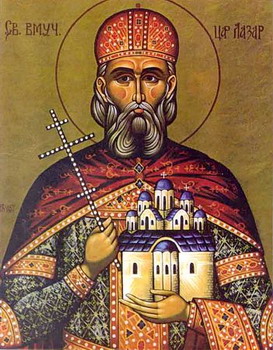 Born in the village of Tekoa, close to Bethlehem, he was of simple birth and lived a simple life. Amos was a herdsman for rich men in Jerusalem. But God, who never looks into 'Who's Who', and judges a man by the purity of his heart and not by his external appearance, the same God who took Moses and David from their sheep to make them leaders of the nation; this same God also took Amos to be His prophet. Amos rebuked King Uzziah and his pagan priests for their idolatry and turned the people from the worship of the (,olden calves, teaching them to worship the one, only and living God. When Amaziah, the chief of the pagan priests, began to persecute him, he prophesied the triumph of the Assyrians over Israel, the slaying of King Jeroboam and Amaziah's sons and the defiling of his wife by the Assyrian soldiers before his own eyes, because Amaziah had led the nation into adultery with idols. And so it all came to pass. The son of the priest struck the prophet on the forehead with a staff so forcefully that he fell down. He was carried, barely alive, to his village of Tekoa, where he surrendered his holy soul to God. He lived in the 8th century before Christ. Born in the village of Tekoa, close to Bethlehem, he was of simple birth and lived a simple life. Amos was a herdsman for rich men in Jerusalem. But God, who never looks into 'Who's Who', and judges a man by the purity of his heart and not by his external appearance, the same God who took Moses and David from their sheep to make them leaders of the nation; this same God also took Amos to be His prophet. Amos rebuked King Uzziah and his pagan priests for their idolatry and turned the people from the worship of the (,olden calves, teaching them to worship the one, only and living God. When Amaziah, the chief of the pagan priests, began to persecute him, he prophesied the triumph of the Assyrians over Israel, the slaying of King Jeroboam and Amaziah's sons and the defiling of his wife by the Assyrian soldiers before his own eyes, because Amaziah had led the nation into adultery with idols. And so it all came to pass. The son of the priest struck the prophet on the forehead with a staff so forcefully that he fell down. He was carried, barely alive, to his village of Tekoa, where he surrendered his holy soul to God. He lived in the 8th century before Christ.+++ The Holy Martyr Lazar, Prince of Serbia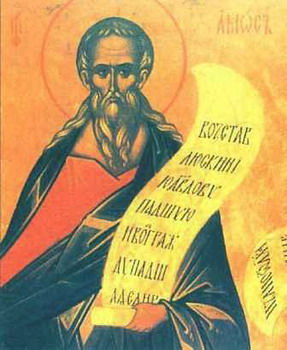 He was one of the greatest men of Serbia who ruled the kingdom after King, Dusan. Upon the death of King Uros, Lazar was crowned King of Serbia by Patriarch Ephraim. He sent a delegation to Constantinople, including a monk called Isaiah, to plead for the removing of the anathema from the Serbian people. He went to war on several occasions against the Turkish Pasha, finally clashing with the Turkish king, Amurat, at Kosovo on June 15th 1389, being slain there. His body was taken to Ravanica near Cupria, a foundation of his, and buried there, but was later taken to New Ravanica in Srem. During the Second World War, in 1942. it was taken to Belgrade and placed in the Cathedral, where it is preserved to this day, and offers comfort and healing to all who turn to him in prayer. He restored Hilandar and Gornjak, built Ravanica and the Lazarica in Krusevac and was the founder of St Panteleimon, the Russian monastery on the Holy Mountain, as well as numerous other churches and monasteries. He was one of the greatest men of Serbia who ruled the kingdom after King, Dusan. Upon the death of King Uros, Lazar was crowned King of Serbia by Patriarch Ephraim. He sent a delegation to Constantinople, including a monk called Isaiah, to plead for the removing of the anathema from the Serbian people. He went to war on several occasions against the Turkish Pasha, finally clashing with the Turkish king, Amurat, at Kosovo on June 15th 1389, being slain there. His body was taken to Ravanica near Cupria, a foundation of his, and buried there, but was later taken to New Ravanica in Srem. During the Second World War, in 1942. it was taken to Belgrade and placed in the Cathedral, where it is preserved to this day, and offers comfort and healing to all who turn to him in prayer. He restored Hilandar and Gornjak, built Ravanica and the Lazarica in Krusevac and was the founder of St Panteleimon, the Russian monastery on the Holy Mountain, as well as numerous other churches and monasteries.The Holy Martyr Vitus, with Modestus and Crescentia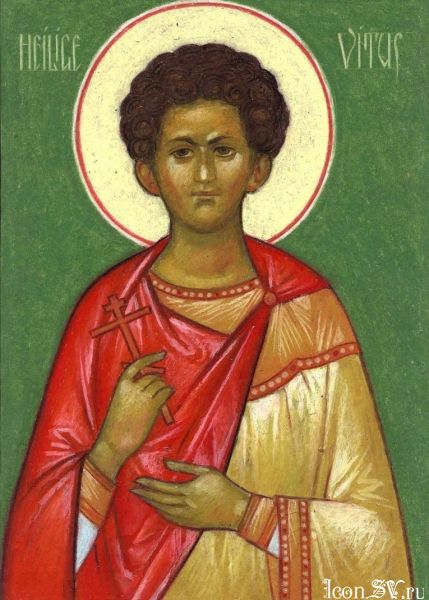 St Vitus was born in Sicily of eminent pagan parents. Modestus was his tutor and Crescentia his governess. St Vitus was baptised early and, when only twelve years old, began to live an intensive ascetic life. Angels appeared to him, instructing him and encouraging him in his labours, and he was himself as radiant and handsome as an angel of God. A judge who beat him had the flesh of his arm wither away, but Vitus healed it by his prayers. His father was blinded when he saw twelve angels in his room "with eyes like stars and faces like lightning", but Vitus restored his sight by his prayers. When his father sought to kill him, an angel appeared to him and took him to Lucania on the bank of the river Silaris, together with Modestus and Crescentia. St Vitus performed many miracles there for the sick and insane. He went to Rome at the summons of the Emperor Diocletian and drove out an evil spirit from his son. Far from rewarding him, the Emperor tortured him cruelly when he would not bow down before mute idols, but the Lord delivered him from torture and returned him to Lucania by His invisible arm, and there he and Modestus and Crescentia entered into rest in the Lord. St Vitus"s relics are preserved in Prague. St Vitus was born in Sicily of eminent pagan parents. Modestus was his tutor and Crescentia his governess. St Vitus was baptised early and, when only twelve years old, began to live an intensive ascetic life. Angels appeared to him, instructing him and encouraging him in his labours, and he was himself as radiant and handsome as an angel of God. A judge who beat him had the flesh of his arm wither away, but Vitus healed it by his prayers. His father was blinded when he saw twelve angels in his room "with eyes like stars and faces like lightning", but Vitus restored his sight by his prayers. When his father sought to kill him, an angel appeared to him and took him to Lucania on the bank of the river Silaris, together with Modestus and Crescentia. St Vitus performed many miracles there for the sick and insane. He went to Rome at the summons of the Emperor Diocletian and drove out an evil spirit from his son. Far from rewarding him, the Emperor tortured him cruelly when he would not bow down before mute idols, but the Lord delivered him from torture and returned him to Lucania by His invisible arm, and there he and Modestus and Crescentia entered into rest in the Lord. St Vitus"s relics are preserved in Prague.Our Holy Father Doulas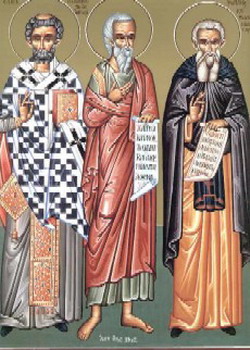 He lived a holy life in an Egyptian monastery. Some of the brethren living in the monastery falsely accused him of blasphemy out of envy towards him, saying that he had stolen from the church things they had themselves taken. The innocent Doulas was stripped of his habit and handed over to the governor for trial. The prince had him flogged and would have cut off his hands, according to the law for such offences, but Doulas"s fellow-monks repented and declared his innocence. He returned to his monastery after twenty years of exile and humiliation, and went to his rest in the Lord on the third day. His body disappeared in a miraculous way. He lived a holy life in an Egyptian monastery. Some of the brethren living in the monastery falsely accused him of blasphemy out of envy towards him, saying that he had stolen from the church things they had themselves taken. The innocent Doulas was stripped of his habit and handed over to the governor for trial. The prince had him flogged and would have cut off his hands, according to the law for such offences, but Doulas"s fellow-monks repented and declared his innocence. He returned to his monastery after twenty years of exile and humiliation, and went to his rest in the Lord on the third day. His body disappeared in a miraculous way.St Ephraim, Patriarch of Serbia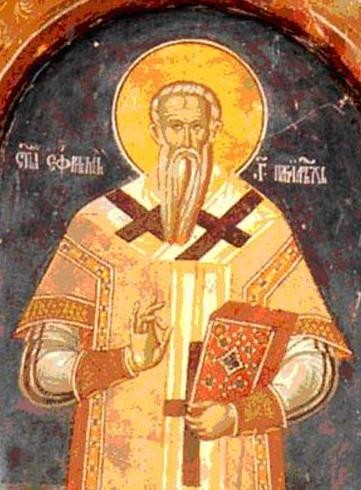 The son of a priest, he had from his boyhood hungered for a spiritual and ascetic life. He ran away to the Holy Mountain when his parents wished him to marry, and returned later to live in a canyon of the river Ibar, and then at Decani. When rivalry and fighting for precedence broke out in the state and also, unhappily, in the Church, the Synod chose Ephraim as Patriarch in place of the deceased Sava, in 1375. When he was informed of their choice, he broke into bitter weeping, but could not refuse. He crowned Prince Lazar in 1382, then renounced his own throne, handing it on to Spiridon, and withdrew once again into solitude. But, upon Spiridon"s death in 1388, Prince Lazar besought him to shoulder the burden once again. He led the Serbian Church through the difficult period of the defeat at Kosovo and until his death in 1400. He was eighty-eight when he went to the Lord whom he loved. His relics are preserved in the monastery at Pec. The son of a priest, he had from his boyhood hungered for a spiritual and ascetic life. He ran away to the Holy Mountain when his parents wished him to marry, and returned later to live in a canyon of the river Ibar, and then at Decani. When rivalry and fighting for precedence broke out in the state and also, unhappily, in the Church, the Synod chose Ephraim as Patriarch in place of the deceased Sava, in 1375. When he was informed of their choice, he broke into bitter weeping, but could not refuse. He crowned Prince Lazar in 1382, then renounced his own throne, handing it on to Spiridon, and withdrew once again into solitude. But, upon Spiridon"s death in 1388, Prince Lazar besought him to shoulder the burden once again. He led the Serbian Church through the difficult period of the defeat at Kosovo and until his death in 1400. He was eighty-eight when he went to the Lord whom he loved. His relics are preserved in the monastery at Pec.Blessed Augustine, Bishop of Hippo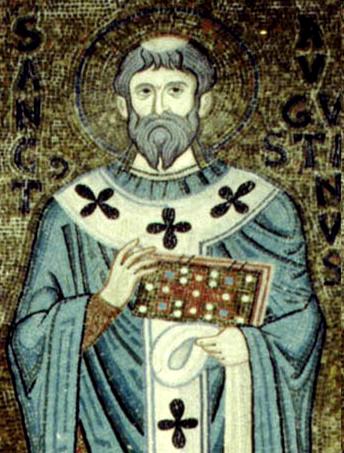 He was turned from paganism to Christianity through the advice, tears and prayers of his mother, Monica. He was a great Doctor of the Church and an influential writer, but with certain unacceptable extremes in his teaching. He Served and glorified the Lord for thirty-five years as Bishop of Hippo and lived seventy-six years on earth in all, from 354 to 430. He was turned from paganism to Christianity through the advice, tears and prayers of his mother, Monica. He was a great Doctor of the Church and an influential writer, but with certain unacceptable extremes in his teaching. He Served and glorified the Lord for thirty-five years as Bishop of Hippo and lived seventy-six years on earth in all, from 354 to 430.Venerable Dulas the Passion-bearer of EgyptThe Monk Doulos the Passion-Bearer ( the time of his life is unknown), was a monk at one of the Egyptian monasteries. He distinguished himself by his meekness, humility and obedience. During the course of 20 years the monk endured the mockery, abuse and contempt of several of the monastic brethren. At first it was difficult for him to bear the deed of forbearance and humbly endure the insult, but continually humbling himself in soul and praying to God, he reached such a degree of passivity, that with all his heart he pitied his detractors and prayed for them...
St. Spyridon, patriarch of Serbia (1388)Saint Spyridon, Patriarch of Serbia (1382-1388), was much concerned about the monastic communities during difficult years of civil and ecclesial unrest. He was consecrated by St Ephraim II, Patriarch of Serbia (1367-1382), who then withdrew to the Archangelsk monastery of the Dushan church. St Spyridon termed Church singing “a spiritual flute,” and evidently he wrote church hymns for the Serbian Church. The saint died at almost the same time as the holy Prince Lazar (June 15), who was killed in the battle with the Turks at Kosovo Pole.
After the death of St Spyridon, the guidance of the Serbian Church was again placed upon St Ephraim II.
Apostle FortunatusApostle Achaicus
Apostle StephenAbout the Holy Disciple Stephen the Holy Apostle Paul recollects in the 1st Epistle to the Corinthians (1 Cor. 16: 15-18). The Apostle Paul wrote: "I am joyful in the arrival of Stephen, Fortunatus and Achaecus: they have made up for me your deficiencies, wherefore they have set at rest both my spirit and your spirit. Respect such".
St. Jonah, metropolitan of Moscow (1461)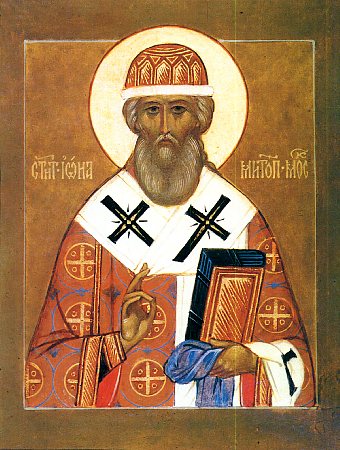 Sainted Jona, Metropolitan of Moscow and WonderWorker of All Russia, was born in the city of Galich into a pious Christian family. The father of the future saint was named Feodor. At twelve years of age the youth took monastic vows in one of the Galich monasteries, from which he transferred to the Moscow Simonov monastery, where for many years he fulfilled various obediences. One time Sainted Photii, Metropolitan of Moscow (Comm. 27 May and 2 July), visited at the Simonov monastery and after the molieben, having blessed the archimandrite and brethren, wanted also to bless the monks fulfilling obedience at the monastery tasks. When he came to the bakery, he saw then the monk Jona asleep from much work, and the right hand of the fatigued monk was bent in a gesture of blessing... Sainted Jona, Metropolitan of Moscow and WonderWorker of All Russia, was born in the city of Galich into a pious Christian family. The father of the future saint was named Feodor. At twelve years of age the youth took monastic vows in one of the Galich monasteries, from which he transferred to the Moscow Simonov monastery, where for many years he fulfilled various obediences. One time Sainted Photii, Metropolitan of Moscow (Comm. 27 May and 2 July), visited at the Simonov monastery and after the molieben, having blessed the archimandrite and brethren, wanted also to bless the monks fulfilling obedience at the monastery tasks. When he came to the bakery, he saw then the monk Jona asleep from much work, and the right hand of the fatigued monk was bent in a gesture of blessing...Venerable Orsiesius of TabennThe Monk Ortesios (Orseses) Tabennisiotes (+ 380) was the successor of the Monk Pakhomias the Great (+ 348, Comm. 15 May). While still in his early years he attained to such a degree of spiritual experience, that the Monk Pakhomias entrusted to him the governance of the Khenobossa monastery. Once the Monk Pakhomias, conversing with his students, said about the Monk Ortesios: "I tell you, that Ortesios doth shine in the house of God, like a golden lamp". After the end of the Monk Pakhomias, Saint Ortesios against his will was chosen as head of the Tabennisiotan monks. To such a number did the brethren increase, that the Monk Ortesios appointed as his helper the Monk Theodore, and then gave over to him the complete rule of the monastery, while he himself withdrew to the Khenobossa monastery...
Venerable Jerome (Hieronymus) of Stridonium (420)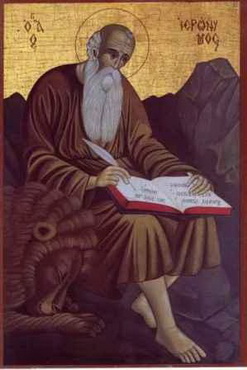 Blessed Jerome of Stridona was born into a Christian family in the city of Stridona (Dalmatia or Pannonia). For the completion of his education his parents sent him to Rome, where he studied the secular sciences. At the beginning of his life in the capital, the youth was captivated by worldly vanities, but soon there matured a decision to change his life to the very core. When the youth was about 20 years old, he accepted holy Baptism. After this he visited in Gaul (France). Here for Saint Jerome there awakened the desire to dedicate himself totally to God and accept monasticism... Blessed Jerome of Stridona was born into a Christian family in the city of Stridona (Dalmatia or Pannonia). For the completion of his education his parents sent him to Rome, where he studied the secular sciences. At the beginning of his life in the capital, the youth was captivated by worldly vanities, but soon there matured a decision to change his life to the very core. When the youth was about 20 years old, he accepted holy Baptism. After this he visited in Gaul (France). Here for Saint Jerome there awakened the desire to dedicate himself totally to God and accept monasticism...Blessed Augustine, bishop of Hippo (430)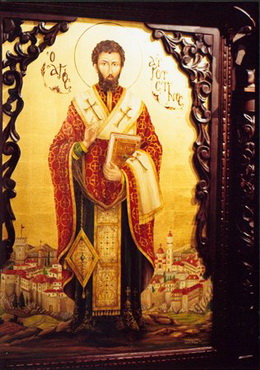 Blessed Augustine was born in Africa, in the city of Tagaste (Thagaste). He was raised by his mother, the pious Christian Monica, and he received his education at Carthage. In the capacity of professor of rhetoric, Augustine arrived at Mediolanum (Milan in Italy) during the period of episcopacy of Sainted Ambrose (+ 397, Comm. 7 December). Under the guidance of Saint Ambrose, Augustine studied the Holy Scriptures. The Word of God produced in his soul a radical crisis – he accepted holy Baptism, gave all his wealth to the poor and was vowed into the monastic form... Blessed Augustine was born in Africa, in the city of Tagaste (Thagaste). He was raised by his mother, the pious Christian Monica, and he received his education at Carthage. In the capacity of professor of rhetoric, Augustine arrived at Mediolanum (Milan in Italy) during the period of episcopacy of Sainted Ambrose (+ 397, Comm. 7 December). Under the guidance of Saint Ambrose, Augustine studied the Holy Scriptures. The Word of God produced in his soul a radical crisis – he accepted holy Baptism, gave all his wealth to the poor and was vowed into the monastic form...Venerables Gregory and Kassian of Avnezh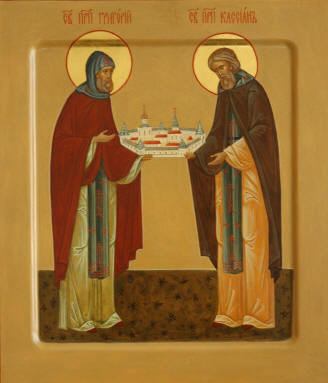 The Monks Gregory and Kassian of Avnezh pursued asceticism at the River Sukhona in the Vologda land. On 15 June 1392 they died as martyrs at Avnezh monastery during an incursion by Tatars. The relics of the monk-martyrs were uncovered in the year 1524. In 1560, with the blessing of Makarii, – Metropolitan of Moscow and All Russia (+ 1564), the hegumen of Makrisch monastery Varlaam composed an account about the sanctity of the monk-martyrs. The Monks Gregory and Kassian of Avnezh pursued asceticism at the River Sukhona in the Vologda land. On 15 June 1392 they died as martyrs at Avnezh monastery during an incursion by Tatars. The relics of the monk-martyrs were uncovered in the year 1524. In 1560, with the blessing of Makarii, – Metropolitan of Moscow and All Russia (+ 1564), the hegumen of Makrisch monastery Varlaam composed an account about the sanctity of the monk-martyrs. |